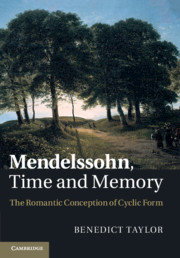Introduction
Published online by Cambridge University Press: 05 November 2011
Summary
The early instrumental works of Felix Mendelssohn are quite extraordinary for their pioneering use of cyclic form. This series of pieces, dating from the latter half of the 1820s, takes up the idea of thematic recall and ongoing development across the separate movements of an instrumental work to a degree unprecedented in previous music and one unsurpassed until the late works of Franck some sixty years later. At a time when Beethoven was still alive, and predating virtually all other attempts in the medium, the young composer was developing a formal principle that would have a decisive impact on the idea of instrumental form for the next century and a half. In works such as the Piano Sextet (1824), the B minor Piano Quartet, Op. 3 (1824–5), the Octet (1825), Piano Sonatas in E and B♭ major (1826 and 1827) and the A minor and E♭ Quartets, Opp. 13 and 12 (1827 and 1829), the principles of thematic recollection and metamorphosis are fused into a new paradigm of musical form and unity. Even more intriguingly, after the age of twenty, with this succession of cyclic masterpieces behind him, Mendelssohn seemed to turn his back on this principle that he had so brilliantly espoused in these youthful works. His instrumental music would continue to grow in range and depth, but the radical formal designs and cyclic recall of these earlier pieces would be modified into the more subtle structures of his mature music and a more restrained process of cyclical thematic growth and transformation.
This book investigates this remarkable use of cyclic form in Mendelssohn's music, both in his works of the 1820s and throughout the subsequent development of this principle in his later music of the 1830/40s. This topic is set against the wider backdrop of the problem of instrumental form in the Romantic era; as the first composer in the generation following Beethoven who engaged convincingly with the compositional issue of musical form and large-scale coherence in instrumental music, Mendelssohn assumes considerable importance here, and these cyclic pieces form a significant part of his achievement. A further subtext of this investigation is a desire to contribute towards understanding cyclic form and its development across the nineteenth century more generally, a subject which has received remarkably little attention. Mendelssohn is without doubt the most pivotal figure here in its early development before Franck and the French school of the late nineteenth century.
- Type
- Chapter
- Information
- Mendelssohn, Time and MemoryThe Romantic Conception of Cyclic Form, pp. 1 - 5Publisher: Cambridge University PressPrint publication year: 2011



